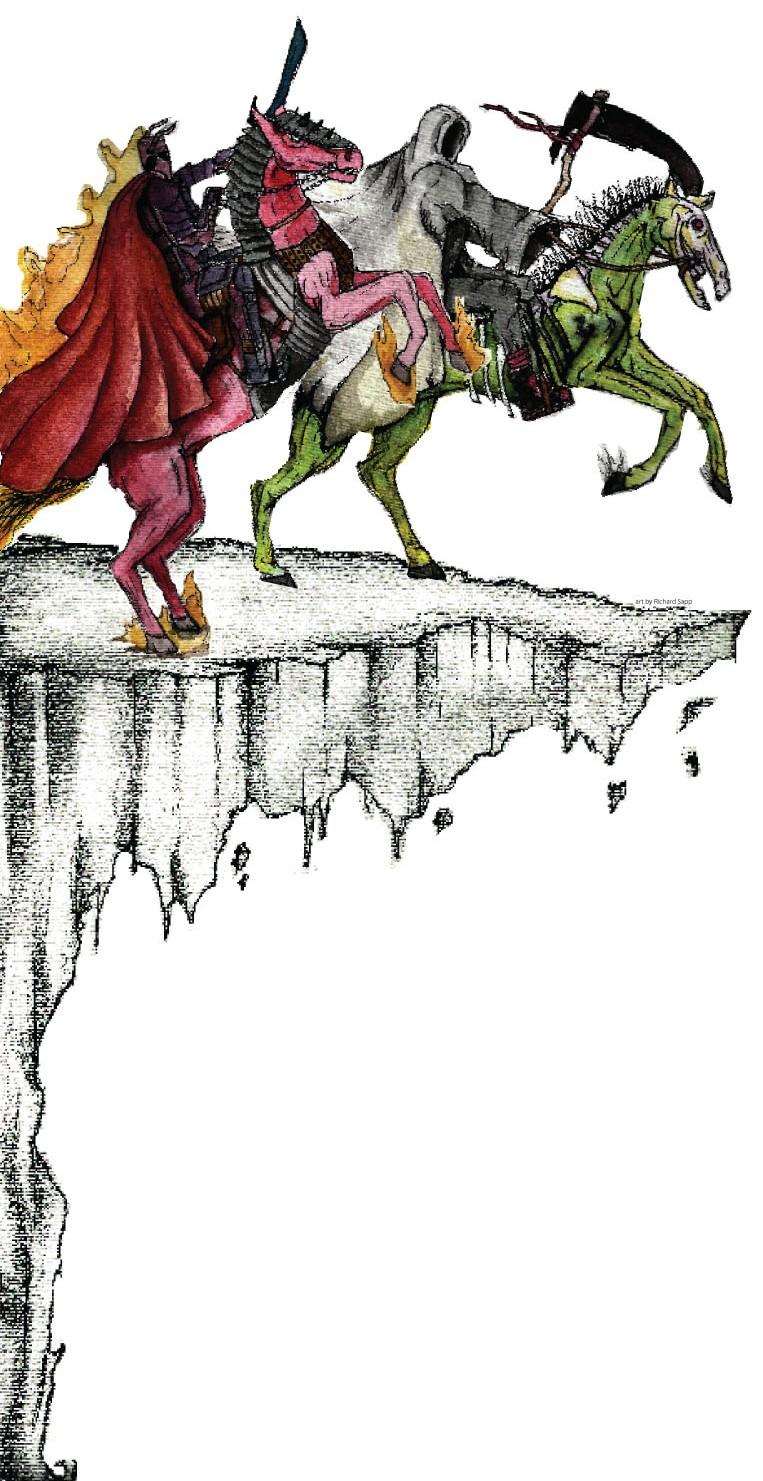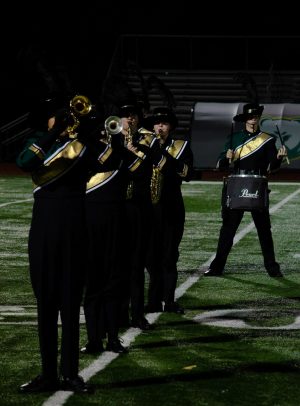Is it the End of the World as we know it?
In December, The ROCK looked at the Maya 2012 Doomsday Apocalypse and reported on other destructive and disastrous events.

Media fuels apocalpyse
First, she said, there is a plane. It’s a commercial airliner or larger, perhaps an Airbus. The destination isn’t specific, some Pacific island undisturbed by human footsteps.
Onboard are family and friends; the inside of the plane is an open floor plan more similar to a cargo jet, and the persons onboard are sitting, talking, laughing.
It might not be the safest thing — no seat belts — but senior Morgan Widhalm said it won’t matter as much at the end of the world.
The concept of apocalypse is as old as the Earth itself, and civilizations have been visualizing what the final days might look like since the Neolithic Revolution. The Egyptians thought a snake would consume the sun, and the Vikings believed the wolf Fenrir would kill their god Odin. In Ancient Persia, denizens believed that a great river of molten iron would burn those who sinned.
In the Information Age, end of the world prophecy has only grown in popularity. Multiple movies spin tales of the end and the aftermath (“The Road,” “Seeking a Friend for the End of the World”) and a quick Google search for “end of the world prophecy” yields millions of results proclaiming the end.
The most popular prophecy by far, however, is the scheduled end of the Mayan “Long Count” calendar, which is set to signal the end of the world on Dec. 21, 2012.
The calendar itself does not speak of the end of the world, nor of how the world would end. Popular doomsday theories over why the Mayans predicted this day for the end of the cycle include the collision of a planet with Earth, the coming of an alien planet “Nibiru” and the shift of Earth’s magnetic poles, alongside other environmental reasons, according to the Search for Extraterrestrial Intelligence Institute’s website.
Though many regard the 21st date with derision — astrophysicist Neil deGrasse Tyson tweeted, “End-of- world prophecies for 2012 are hoaxes perpetrated by the scientifically illiterate on the scientifically under-informed” — some students think the questions that come from end of the world beliefs are worth considering.
 Widhalm is one of them. She isn’t about to die nor does she believe the world is about to end, but Widhalm thinks the annihilation of the human race can raise some valid questions — who to be with? Where to go?
Widhalm is one of them. She isn’t about to die nor does she believe the world is about to end, but Widhalm thinks the annihilation of the human race can raise some valid questions — who to be with? Where to go?
Whether the world ends today or in a billion years, Widhalm said she’d concentrate on people no matter what.
People “are the things I would miss the most, were I to die,” Widhalm said. “I feel like it would be then more for all of us together — less of a get in one last word and more of a party, making sure your last day is the best day you’ll ever [have].”
Though Widhalm favors a view of the apocalypse on an atomic level, focusing on family and friends, Dr. Victoria Johnson, sociology professor at the University of Missouri-Columbia, said the grandeur and complexity of doomsday prophecies have captivated many in the past century. There has been an increase of other theories in the past decades, said Johnson, who holds a PhD in social theory and comparative history.
“Prior to the year 2000, there was an increase in xxn cults that believed that Jesus was returning. There are many other cults that also have doomsday predictions,” Johnson said in an email interview. “Such predictions have existed for thousands of years although the media and technology to communicate such concerns is a late twentieth century development.”
Senior Maddie Jones said the media have heavily hyped the Dec. 21 doomsday event. She believes something will happen on that day but that the media have interest in the event beyond simply informing the populace.
“I think the media definitely displays [the apocalypse] so people would maybe get interested, or, I think it definitely keeps people interested, at least the majority,” Jones said. “They hype any topic. I think it’s one that can universally affect everyone, that’s why it’s so widespread. I think they’re just trying to get money off of it.”
While some media outlets may act unscrupulously with doomsday prophecies, Professor Bill Allen, assistant professor of Journalism Studies at the University of Missouri-Columbia, said the media are not necessarily covering the apocalypse prediction itself, but the surrounding social phenomenon.
“People like to read curious stories about curious things, including predictions and events. And the other part of the media, the part that’s responsible for covering news responsibly, reports on it because it’s a social phenomenon,” Allen said. “People are responding and getting excited about predictions like this, and that’s worthy of coverage. That’s news in itself.”
Leading up to Dec. 21, Johnson believes the amount of coverage, regardless of whether the media report on news or social phenomenon, will increase.
This may result in more programs on cable television and possibly some more entertainment segments on mainstream broadcast airings.
Johnson believes there will also be more activity related to the topic on social networking sites because the media hopes to increase the number of viewers by increasing coverage.
“Television stations certainly use such themes to attract audiences and increase ratings regardless of evidence that supports them,” Johnson said. “Over the last few decades we have seen increasing amounts of ‘infotainment’ (less news, more celebrity) and sensationalist programming to increase profits, ‘doomsday’ programs among them.”
Regardless of the media, Jones will be nervous on the day.
But despite her uneasiness, she intends to act logically and thinks everyone should follow their normal routine. If the world doesn’t end, Jones doesn’t want to be in a tough spot.
“I bet there are definitely some people in the world who are going to go to extremes on that day, like blow all their money in Vegas, and do something like that,” Jones said. “And they’re going to be in trouble afterwards. I’m going to be smart about it. I’m not going to do anything drastic.”
For Widhalm, gambling with life savings in Las Vegas, Nev. on the world’s final day would be a wasted opportunity. She said the end of the world offers a unique degree of freedom.
It would be most important, Widhalm said, to recognize those who shaped her life, but also to clear the air between her and anyone she had conflicts with in the past and ask questions that she had pondered her whole life.
“When you think you have a long life ahead of you, you kind of sit with these things that aren’t right, but you don’t want to say anything. Or you always wanted to know something, but you would never say it because you would have to live another day,” Widhalm said. “What I kind of pictured — even though it probably wouldn’t happen — is gathering up everybody that I love, until I can’t think of any more people, putting them on a jet plane and just flying to some place — just spending our time talking and clearing up whatever we needed to do.”
By Atreyo Ghosh and Adam Schoelz
On a pale horse
Duck and cover: Columbia faces implications of nuclear war

Mankind might be moving forward technologically and culturally at a stunning rate, but violence continues to break out across the globe on a daily basis.
According to a United Nations study, 44 major armed conflicts are ongoing worldwide, with 13 of them annually producing over 1,000 casualties each. With so many raging conflicts, the threat of someone going overboard and using the nuclear option increases.
To many, the nuclear bomb developed by the Manhattan Project has been a terrifyingly, frighteningly modern ultimatum in the world of warfare.
According to a research study performed on American youths by Stanislav K. Roschin and Tatiana S. Kabachenko, even preadolescent children who believe nuclear war to be improbable frequently sketch crude pictures of nuclear bombs and mushroom clouds when asked to draw their fears.
However, nuclear weapons are just another link in the chain of man’s inhumanity to man, according to Mark Prelas, a member of the University of Missouri-Columbia’s Nuclear Technology Department. Prelas also served as chief scientist for a strategic defense board in America.
He said they’re neither a final step morally nor technologically for the military but are, instead, an inevitable manifestation of humanity’s aggression.
“I don’t think any weapon is ethical,” Prelas said. “But that seems to be the history of man, creating a new technology and then weaponizing it.”
Prelas said there’s been talk among the scientific and military communities about the possible militarization of other recently discovered technologies, especially in the online and biotech fields.
Such scientific discoveries could, in theory, apply to warfare principles in a manner similar to the mid-twentieth century finds in atomics, Prelas said. Atomic and nuclear research itself is an expanding field, and newer discoveries often find their way into the military.
Not all military gear based on nuclear technology is deadly, though. The military currently researches and makes use of a diverse array of nuclear devices. Some of them are aggressive in nature; others are more passive.
“There’s applications for weapons, explosives and power sources and diagnostics,” Prelas said. “In diagnostics, nuclear tech can be used to create devices that can pick up on hidden nuclear activity being implemented in weapons.”
However, nuclear weapons’ destructive potential puts them, in the eye of the public, far ahead of any other weapon in terms of fascination and fear, English teacher Deborah McDonough said. She still remembers the impact the Cold War and Cuban Missile Crisis had on the public during her childhood.
“I recall very clearly that we used to have nuclear bomb shelter signs up in our high school,” McDonough said. “I remember the teachers going over ‘in case of’. They never said nuclear, but in case of an ‘invasion,’ we knew exactly where to go.”
She also recalls many U.S. citizens, including her neighbors up the street, constructing bomb shelters and keeping them regularly stocked with canned food and other supplies. Some nights she would lay awake wondering about how her family would survive if there was an attack.
“I told my dad one day, ‘You need to get some big bags of sand,’” McDonough said. “And he said, ‘Why?’ and I said, ‘Because if we put the bags up in the windows, that’ll keep the radiation from coming in.’”
It’s possible to survive a nuclear blast, Prelas said, even at ground zero; but it isn’t likely. A nuclear bomb operates on three different deadly levels of devastation upon detonation, Prelas explained; it is a thermal, radioactive and seismic cocktail of desolation.
A bomb similar in size to the ones dropped on Nagasaki and Hiroshima in Japan not only creates an impressive amount of incineration, but also spreads radiation across a half mile radius and generates a shock wave travelling nearly double that distance.
Such destructive capabilities have only once been seen in action, at the end of World War II 67 years ago. In the decades following the bombings in Japan and the later nuclear standoff between Russia and the U.S., tensions regarding nuclear warfare remain high in the U.S.; a poll conducted seven years ago by MSNBC showed that 52 percent of Americans expected nuclear war to have broken out by now.
The rising tensions in Israel and Iran last year seem to lend some credence to those fears. Iranian scientists are allegedly on the way to amassing enough uranium for a nuclear bomb. In his response, Israeli prime minister Benjamin Netanyahu appealed to the U.N. and the U.S. during recorded public sessions of the U.N. to take action against his Iranian neighbors.
During a press conference, Iran’s president, Mahmoud Ahmadinejad, countered with a claim that Israel was trying to manipulate the American military into attacking Iran without provocation. According to the The Washington Post and ABC News, politicians are trading threats across both sides of the Israeli-Iranian border, and debate rages throughout Washington D.C. regarding how the U.S. diplomats, politicians and military should approach the issue.
This debate between political parties and ideological affiliations has even spread to RBHS. Senior and Young Republicans president Mallory Short said Iran poses a major threat to America’s Middle Eastern allies.
“I think that Iran’s nuclear program is the most difficult national security issue facing the United States,” Short said. “If they have nuclear capabilities, they will wipe Israel off the face of the Earth.”
There is some disagreement as to how much of a threat Iran poses to its neighbors. Senior Michael Hawke has researched the Iranian-Israeli conflict extensively as a member of Model U.N. He said most people don’t fully understand the nature of Iran’s nuclear program and are unnecessarily concerned about the danger it presents.
“Yes, they have developed a large amount nuclear weapon-grade uranium. However, it’s important to remember that, in order to use nuclear-grade uranium, you need a nuclear missile,” Hawke said. “Currently, they don’t have the technologies or the ability to construct such a missile, so unless they just want to hurl it over the border by hand, they’re not a nuclear threat and won’t be a viable one for years to come.”
As far as American involvement in the situation, Short said she believes it’s unacceptable for Iran to possess nuclear weapons capability, but that the U.S. should reserve force as a last resort.
“Really I just think that the U.S. and Iran need to sit down and have a little chat about nuclear weapons,” Short said, “which Iran has always shied away from, seeing that they consider their nuclear program as a vital national interest and don’t wish to sit down with our country, which they refer to as ‘the great Satan.’”
Hawke also opposes trying to invade Iran to solve the issue but doesn’t feel that negotiations are the most viable answer to the tensions. A long term, economic solution, Hawke said, will help to take care of the situation.
“The U.S. has actually put a great host of sanctions on Iran that crippled its economy,” Hawke said. “Over a long term period these will have the potential to destabilize the nation enough to get them back in line with traditional world policy.”
What’s frightening to some military researchers is that in a few decades this concern about nuclear missiles may seem grossly outdated, Prelas said. It’s not that nukes will be any less destructive in the future, but rather that other forms of weapons may soon surpass them in their deadly capabilities.
With the advent of new internet technology an ever-looming global presence, Prelas said, it’s not outlandish to be concerned about a weaponization of online technology. Militaries, Prelas said, could use internet based weaponry to blackout power grids, shut down hospitals and throw economics into chaos.
“A total financial collapse could be created using the internet,” Prelas said. “These new technologies that are just tech right now could become [weapons of mass destruction] that would make nuclear weapons pale in comparison.”
By Jake Alden
East coast weather war zone
Survivors unprepared for onslaught of Hurricane Sandy

Kline, who lives on the eastern side of New York, was in California for business when Hurricane Sandy hit Oct. 29. Benad said because she wasn’t at home, she couldn’t ready her residence for the hurricane while she was away. She could only mentally prepare and hope for the best despite being roughly 2,000 miles away from her home.
“She anticipated the storm; she knew it was coming, and she had the right mindset. But there was nothing she really could have done since she was away from her house,” Benad said. “I guess you can never really prepare for something like that.”
The horrendous, almost 400 foot waves crashing against the East Coast Oct. 29 and 30 demolished buildings, resulted in power outages, hindered hope and took the lives of 97 innocent people in a 65 mile radius of New York, and airlines canceled more than 15,000 flights. This monster of a storm was Hurricane Sandy.
CNN reported that Hurricane Sandy caused more than 7.5 million power outages and caused the deaths of more than 80 people in the U.S., 41 in New York City alone.
With all the damage, loss of electricity and deaths, no one could have prepared for the intensity of the storm.
Benad said Kline is still living with the aftermath and the damage of the two day hurricane, and it hasn’t been easy or cheap.
According to Moody’s Analytics, an economic research corporation related to credit analysis, performance management, financial modeling, structured analysis and financial risk management, approximately $30 billion of losses from the storm is directly damage to property.
Kline was one of many victims Hurricane Sandy took its toll on. When Kline came back from her trip, she found her house with hundreds of dollars worth of damage.
“There was pretty severe water damage done to her house,” Benad said. “I think she’s going to have to get a new roof. I think she may have to replace some of her carpets, too, and her basement was flooded.”
Hurricane Sandy did not only affect Kline; former guidance counselor Matthew Miltenberg witnessed the rage of the hurricane firsthand. Miltenberg was visiting family in New York where he grew up when Hurricane Sandy hit the coast. His family didn’t prepare much, he said, because of last year’s high-intensity warnings about Hurricane Irene, and their minimal preparations never ended up being necessary.
“Much like the story of the boy who cried wolf, everyone figured there wasn’t really anything to worry about this time around either,” Miltenberg said. “Plus, my mom is an Irish Italian mother with three of her sons visiting her home — there was enough food prepared to last us several, several weeks. My wife, being a Midwesterner, kept asking if there was more we should be doing. We joked, acting kind of patronizing, not knowing what was to come.”
Miltenberg’s mother’s house, where the family was staying, was three miles from the ocean. A couple trees got knocked down in their yard, but luckily the trees were far enough from the house that it didn’t cause any damage. Miltenberg said part of the strangeness of the storm was that there was little precipitation with it; the flooding wasn’t as bad as in previous hurricanes. Still, he said, countless trees, rooted in sandy soil, went down easily.
In the aftermath of Hurricane Sandy, Miltenberg’s mother, a special education teacher, took in her teaching aide because the aide lost almost everything in the storm. Since Miltenberg was young, his mother has worked with the aide.
Like his mother, Miltenberg’s brother is also a teacher whose classroom setting went through destruction. The hurricane destroyed the entire first floor of his school. The school relocated to a building in East New York.
“It’s unclear just how many students will still be a part of the school when things settle in,” Miltenberg said. “Right now they are sharing a classroom between three teachers with about 50 kids in each room, three different subjects being taught at once: history, math and Spanish. And you thought paying attention during studies was hard.”
Hurricane Sandy caused destruction, but Miltenberg said not everyone heeded the warnings of the storm. Some chose not to pay attention to the alarm, but when it came to being ready for the hurricane, Miltenberg said the public officials had it pretty well under control.
“I really think the preparation as laid out by public officials couldn’t have been better,” Miltenberg said. “Their evacuation recommendations and the shelter offerings were really pretty accurate and probably did a great deal to make sure that things weren’t worse.”
Although in disasters there are some things more easily controlled than others, Miltenberg said in the future, people will better prepare the infrastructure of public transportation, fuel delivery, repositories, power grids and more generators.
Alex Fribourg, a licensed mental health counselor and psychotherapist living in New York City, said generally the nature of a crisis does not allow time to prepare, and usually natural disasters such as Sandy, or any other hurricane, do not have a predictable outcome.
“Should we have advanced notice, the general preparation guidelines are based in necessity for survival,” Fribourg said in an email interview. “We try to ensure that our clients have somewhere safe to stay, enough food, water, medical care/medicines and clothing to get them through the thick of the problem. Most of our work as mental health professionals usually comes after a crisis occurs.”
Crisis affects each individual and family differently, Fribourg said. The more severe cases are when the clients have either experienced a traumatic loss, such as destruction of their home, a pet or loved one missing, injured or dead. More commonly, however, Fribourg said she will find individuals who are managing inconveniences more than traumas, such as the extended loss of electricity or heat.
In the case of Hurricane Sandy, Fribourg said most affected people suffered loss of wages from their business being closed or being unable to get to work because of the failure of subways and busses.
“In the case of traumatic loss, we generally provide crisis intervention or crisis counseling, which helps the individual to get back on to their feet,” Fribourg said. “For example, we assist in finding the individual lodging, often we can assist in locating a missing loved one or missing pet. Then the long-term work begins in helping the individual rebuild their lives after a traumatic loss. Sometimes their identity can be negatively affected, such as a man, who always considered himself a husband, who lost his wife in a crisis, now has to redefine himself, and we assist him in this transition.”
Clinical psychologists can act as liaisons to other professionals, such a medical professionals, housing boards and shelters in times of crisis. Sometimes the psychologists are dispatched by officials to central locations after a disaster to help comfort and care for the individuals affected by the crisis, doing the same jobs as volunteers, nurses and police officers. This includes handing out food and water or giving teddy bears to children.
Fribourg said the storm did not severely affect any of her clients, so they spent little time outlining a recovery plan, or focusing on rebuilding.
“Generally, should I have had clients with severe loss or trauma, I would probably follow a general protocol of securing basic needs: shelter, food, water, clothing, medical care and contact with loved ones or family,” Fribourg said. “Afterwards, we would begin looking into the specific effects of the disaster, and managing each one. But talk therapy takes a backseat to crisis intervention and securing of basic needs in the immediate aftermath of a hurricane or disaster of any kind.”
By Julia Schaller
















































































